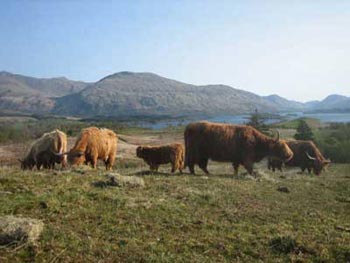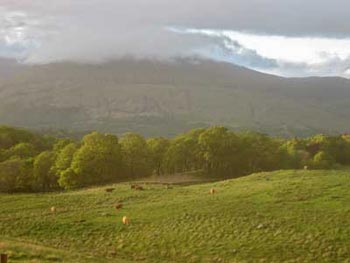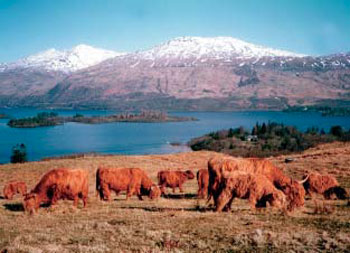About the Cladich Fold
The Fold
The Cladich Fold features in volume 1 of the Highland Cattle Society Herd Book of 1885. Our first prize-winner was Domhnull Ruadh of Cladich, which calved in 1878 and took the silver medal at Inveraray in 1882, making us proud prize-winners since 1882!
While such longevity has a certain cachet, we are judged on our performance today and we are working hard to breed cattle with west highland characteristics. Our aim is to produce beasts which are deep-set, straight backed and with a good gait. We hope for strong heads and in the the females, a ‘sweet’ face. Our emphasis is on quality, not quantity!
In recent years we have introduced new bloodlines into the fold and our bulls are descended from a string of good, well established bloodlines, including the great Joseph of Cladich.


Cladich, on the south side of Loch Awe, ranges from loch-side herbage, ‘in-bye’ pasture, native woodlands and rises to rough hill grazing, where the cattle have to co exist with the sheep, deer, eagles and black grouse ( black cock and grey hens).
The Cladich woods provide the cattle with shelter and good grazing, although in winter we hand feed with meadow hay and cow rolls.
Our aim is to be able to approach and groom all the cattle in the field and while some retain a natural shyness, most enjoy the experience!
Bulls have been exported to Australia, Denmark, Germany, Sweden, Finland and Luxembourg and females to Austria, Belgium, Denmark, France, Germany, Holland, Finland and Switzerland. Cattle are sold privately and in Oban in February and October.

Cladich’s History
Cladich and its surrounding lands have been occupied since earliest times. Bronze age settlers (2000 to 600 BC) left tombs and mysterious ‘cup-marked’ rocks. Later, during the Iron Age, Celtic warrior tribes reached Argyll. Reckoning their wealth in cattle, as the African Matebele tribe do to this day, they built islands of stone and timber, known as crannogs, to protect their herds at night. These man-made islands were connected by causeways to the shore and the cattle, driven across to the mainland to graze by day, were herded back to safety at dusk. Good examples of these crannogs can still be seen in Loch Awe, offshore from Cladich.
Cladich was held by a succession of chiefs of Clan Campbell, latterly Dukes of Argyll, from 1309 until 1775, when it was sold to Campbell of Monzie. It then passed by succession to the Fellowes family, from whom we purchased the estate in 2001. We think we are only the fourth family to own the estate since 1309.


In the seventeenth century Cladich (gaelic: ‘at the shore’) was surrounded by the populous farming townships of Barrandryan, Drumuirk and Keppochan. The peace of the place was not continuous and the inhabitants were often caught up in the battles of their clan superiors. Vengeance was wreaked after the rebellions of 1685, 1715 and 1745. In 1685 the parish was ravaged by Perthshire Athollmen, and according to an account of the time, the ‘robberies and depradations included the seizure of cows, horses, furniture and oats.’ The men of Cladich however learnt to defend themselves and the Militia List of 1803-04 records 29 ‘fencible men’ in Cladich and the surrounding townships. Among them were shepherds, blacksmiths, labourers, a carpenter, a change keeper, a wright, a shoemaker, two tailors and six weavers

The weavers of Cladich, mostly McIntyres, were famous for their garters and hose. The ‘Cladich Garter’, distinctive in red and white, measuring a yard in length and finished with a knot was particularly prized by pipers. This was a flat woven product and not knitted as garters are today. The wool was woven at the mill at Cladich where the looms, the remains of which can still be seen, were driven by water.
Later, iron smelting and the demands of the local tanneries encouraged the local people to coppice oak and charcoal burning hearths abounded. However, steamers on Loch Awe, as well as taking produce away, also brought the outside world to Cladich and there was a gradual depopulation as people were drawn to opportunities further afield. The 1851 census showed occupants as a post-boy, inn-keeper, scholars, dairymaids, a barmaid, a gamekeeper and an Australian sheep farmer who was staying at the inn on the bridge at Cladich, now occupied as a private house.
Cladich and the surrounding hamlets have had a long history of farming and rural industry. In its small way the Cladich Fold of Highland cattle continues this tradition on land that has been farmed and occupied for hundreds, probably thousands of years.

